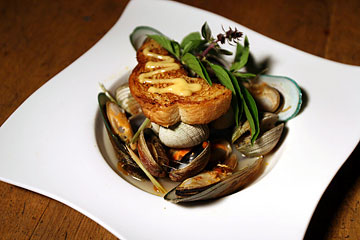
|
Weekly Eater
Nadine Kam
|
 COURTESY AJI HOUSE AT XYLOH Aji House's sake-marinated beef and steamer of clams and mussels are available to Xyloh partiers late night and weekends, or a weekday pau hana crowd. CLICK FOR LARGE
|
|
Aji House at Xyloh onto something
AS MUCH as I love boom times, anyone who's lived a while becomes acquainted with the other half of the cycle, the bust. Those invested heavily in the stock market got a small taste of it over the past two weeks, and it wasn't pretty.
At times like these, I really worry for restaurant owners. It takes a lot of courage to open one because it is such a difficult business, even in good times. More practical souls would avoid the industry, but what I find in many restaurateurs is a daredevil spirit and passion that prevents negative thoughts from entering their minds. Even in the worst of times, new spaces will keep coming, although their appearance may veer from more familiar breakfast, lunch, dinner, family or formal formats.
The Aji House at Xyloh may hold a template for the future, as a partnership between club promoters and chefs. Food in clubs is nothing new, but the menu here seems more inspired than most. It works, in part, because it is small and manageable. I've seen many falter by over-reaching, but these guys are taking it slow to allow their audience to build. Where this will lead, who knows? But one scenario would be to draw enough of a following to launch a more traditional restaurant someday.
Naturally, the party crowd skews young, while an older crowd may find it more comfortable to hang out earlier in the week with the help of pau hana drinks and food created by a cadre of chefs who honed their skills at Hoku's.
But first, you gotta find the place. Given the sketchy combination of the words "Aji's" and "Kona Street," I figured it wouldn't be hard to find. Kona Street is only so long. It proved more challenging than I thought, but when I saw a woman dressed for the office outside Xyloh, the nightclub site formerly home to Reign, I figured that would be a good place to park. Parking is generally full up the ramp next to the building (similar to the Side Street Inn situation), but I'm usually able to find parking in metered stalls on Queen Street.
Stepping behind the curtain in Xyloh's vaguely Gothic, pointy green entryway, I felt reassured by a walkway lined with votives, but when the passage opened into a lounge, I started backing out. I wasn't in a loungey mood.
Busted! Staffers seemed to read my mind and sprang into action before I could run away, assuring that I had found the right place and inviting me to plop down into any of their plush leather sofas, reminiscent of automobile backseats, some with cup holders built in. Well, they did look comfortable.
ONCE SEATED, you'll spot a small bar menu that fills front and back of an acrylic table tent. The fine print may cause eye strain, but if that's the case, just look up. Dishes will flash before your eyes as images on flat-screen TV panels hung throughout the room. There's nothing subliminal about this tactic. Watching all the food appear, fade out and reappear will tempt you to order more than you can eat.
It's a menu beer drinkers will love, with flavors big on a blend of salty, sweet and spicy. No surprise there. "Aji" means "flavor" in Japanese.
Warm up with ahi poke ($8), a two-fer dish that also allows you to get part of your daily requirement of greens. The ahi, tossed with an evenhanded blend of soy, limu and chilies, is accompanied by a shaved green papaya salad drizzled with a soy-ginger reduction.
If you're mainly interested in the fish, poke is a better selection than the Thai roll sushi ($8), which is close to being a salad. It's filled with cucumber and carrots, plus the strong flavors of basil, lemongrass and kaffir lime.
The real hit has been Aji House's sweet sake-marinated slices of beef ($12) with a layer of basil and miso pesto torched onto its surface to form a sweet brulée crust that's topped with crunchy dried onions.
For balance, you might follow that with a milder helping of tofu tataki ($6), the slices seared on the outside, squishy on the inside, topped with kabayaki sauce and shredded scallions.
On ordering the Korean-style chicken wings ($7), we were told not to fear its fire-engine red color. It turned out to be more sweet and salty than fiery, with its mix of ko chu jang and kim chee base. (For those still looking for a Chicken Alice's replacement; this isn't it, but I'm still looking.) What's most amazing about these wings is their crisp skin. Many try but just can't get their oil hot enough to match this.
Those who simply want to talk while nibbling can opt for the ease of salt-and-pepper crispy calamari ($9), or Aji fries ($6). You're offered a choice of toppings with those fries: garlic, Hurricane (furikake and mochi crunch), Chinese five-spice and salt, shiso, Thai herb, cheese or buttermilk dusted.
You also have a pick of sauces to accompany those fries: Southeast aioli, ranch sauce, spicy ketchup (Sriracha hot sauce with ketchup), wasabi aioli, garlic oil or miso tahini.
Given the popularity of this basic finger food, a more extensive fry bar is in the works.
I appreciate Aji House's humble, low-key approach to making food work within an alternative environment and hope this is the start of bigger things to come.

